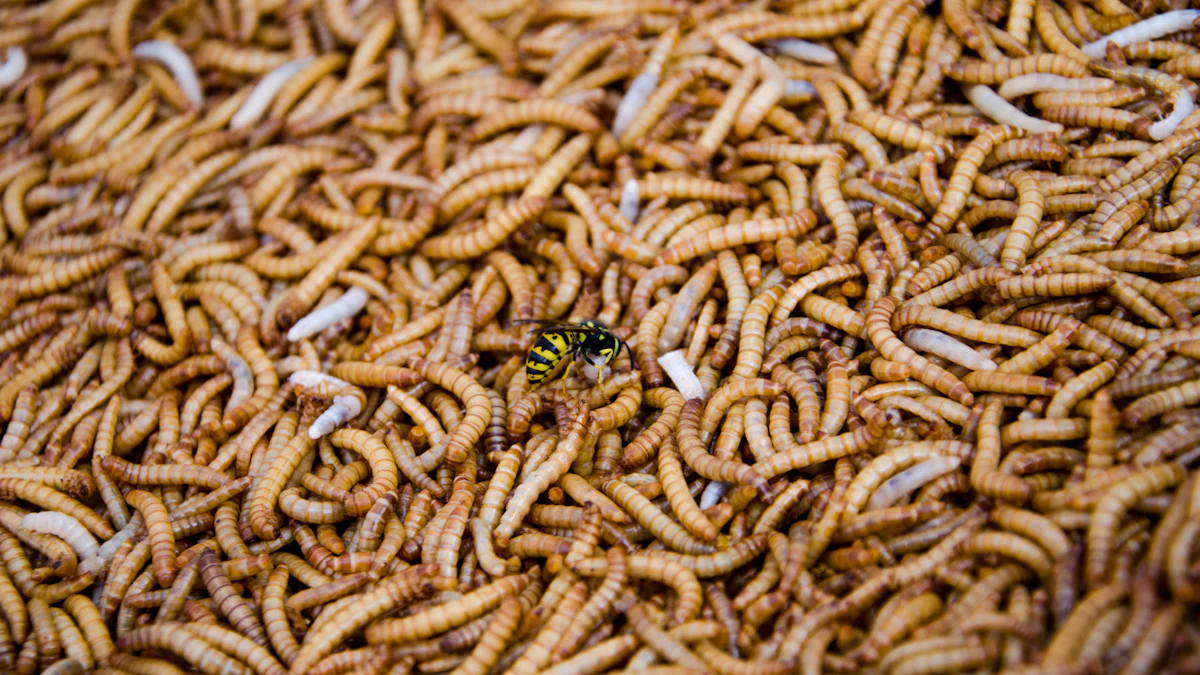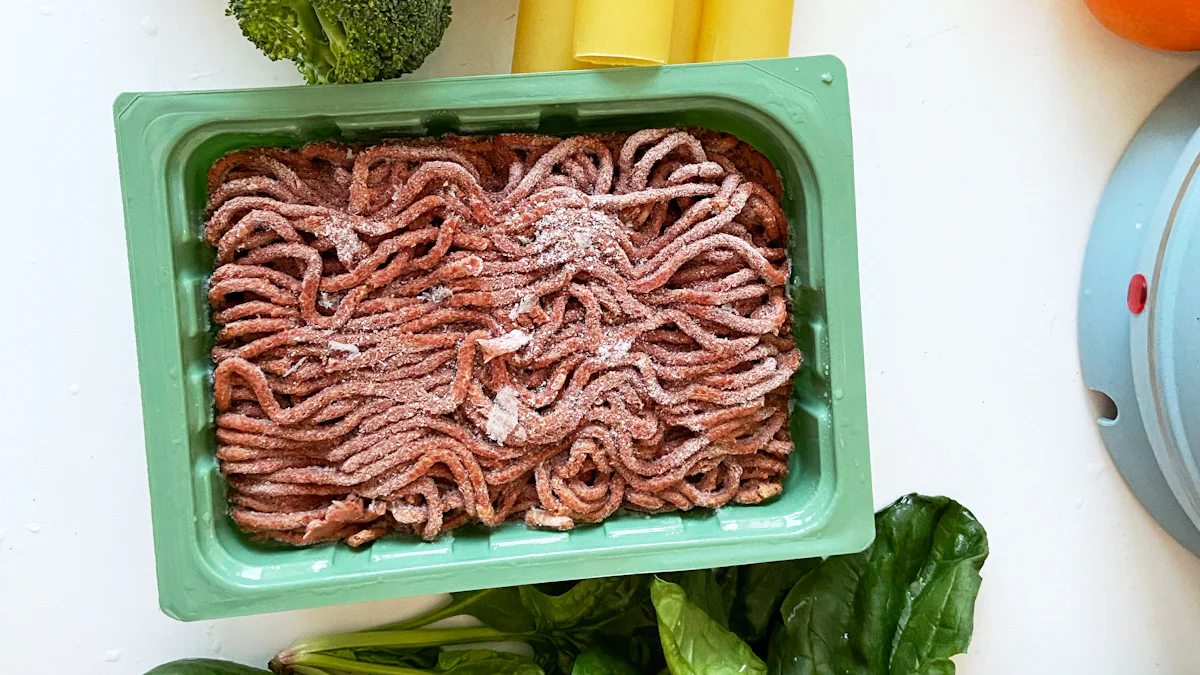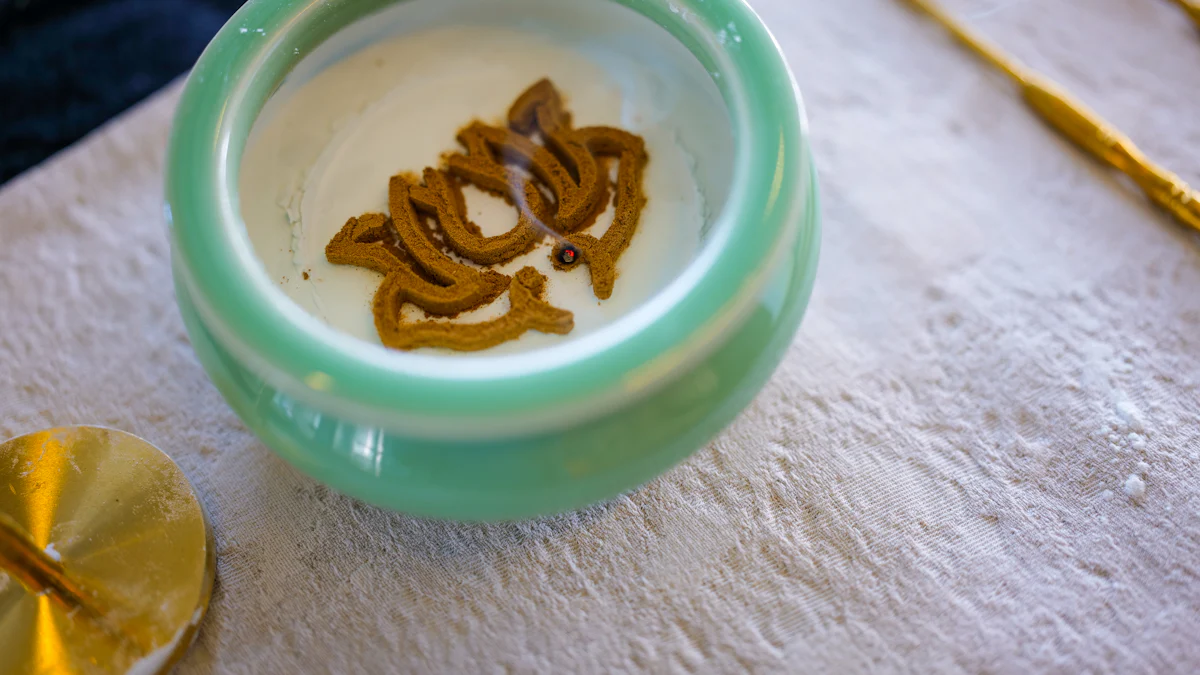
Meet Tenebrio obscurus, the black mealworm, a tiny creature with a big impact! This little beetle’s larvae are not just any bugs; they are a powerhouse in agriculture and sustainability. Imagine a world where black mealworms help reduce food waste by recycling plant materials into high-quality feed. They require fewer resources than traditional livestock, making them an eco-friendly protein source. Their ability to thrive on various substrates turns them into a fantastic bioconversion tool. With their low environmental footprint, black mealworms are paving the way for a greener future.
Key Takeaways
- Black mealworms are eco-friendly protein sources that help reduce food waste by converting organic materials into high-quality feed.
- Their unique ability to thrive on various substrates makes them valuable in sustainable agriculture and composting practices.
- Black mealworms play a crucial role in ecosystems by breaking down organic matter, contributing to nutrient recycling and soil health.
- They require significantly fewer resources than traditional livestock, making them a sustainable alternative for animal feed.
- Research into black mealworms is ongoing, focusing on enhancing their growth and nutritional value for both human and animal consumption.
- These tiny insects hold promise for innovations in biodegradable materials and effective waste management solutions, supporting a circular economy.
- Incorporating black mealworms into diets can provide a nutritious and environmentally friendly protein option, appealing to health-conscious consumers.
Physical Characteristics of Black Mealworms

Let’s dive into the fascinating world of black mealworms! These little critters, known scientifically as Tenebrio obscurus, have some unique physical traits that set them apart from their mealworm cousins.
Appearance
Size and Color
Black mealworms are like the ninjas of the insect world. They sport a matte black appearance, which makes them stand out from the crowd. Unlike their shiny counterparts, these mealworms have a more subdued look. They typically measure between 12 to 18 mm in length. Imagine a tiny, stealthy creature that can easily blend into the shadows!
Distinctive Features
What makes black mealworms truly special? Their distinctive features! These mealworms have a robust body structure, perfect for their role in nature. Their dark color isn’t just for show; it helps them survive in various environments by providing camouflage. This makes them quite the adaptable little insects.
Comparison with Other Mealworms
Now, let’s see how black mealworms stack up against other mealworms.
Differences in Morphology
When you compare black mealworms to their yellow cousins, Tenebrio molitor, you’ll notice some key differences. Black mealworms have a darker hue, which gives them their name. Their body shape is slightly more elongated, making them look like the sleek sports cars of the mealworm world.
Unique Traits
Black mealworms aren’t just about looks. They have some unique traits that make them valuable in agriculture and sustainability. These mealworms are excellent at breaking down organic matter, turning waste into valuable resources. Their ability to thrive on various substrates makes them a versatile choice for eco-friendly farming practices.
Natural Habitat and Distribution

Geographic Range
Native Regions
I find it fascinating that black mealworms, like many of their mealworm relatives, originally hail from the vast expanses of Eurasia. This region, rich in biodiversity, provided the perfect backdrop for these little critters to evolve and thrive. Imagine them scuttling around ancient forests and fields, playing their part in the ecosystem long before humans even knew they existed!
Areas of Introduction
As humans began to explore and expand, they inadvertently became the mealworms’ travel agents. These industrious insects hitched rides on ships and caravans, spreading across the globe. Today, you can find them in many parts of the world, thanks to our penchant for trade and exploration. It’s like they have their own little passports, stamped with destinations far and wide!
Preferred Environments
Climate Preferences
Black mealworms are not too picky when it comes to climate. They have a knack for adapting to various conditions, which is why they can be found in so many places. However, they do have a soft spot for damp environments. Picture them nestled in moist grain stores, happily munching away. Their love for humidity makes them quite the adaptable travelers.
Typical Habitats
In their natural habitat, black mealworms often make themselves at home in damp grain. This environment provides them with both food and shelter. I imagine them as tiny explorers, navigating through the grains like adventurers in a jungle. Their ability to thrive in such conditions makes them valuable in agriculture, where they can help break down organic matter and contribute to efficient bioconversion. It’s like they’re nature’s little recyclers, turning waste into treasure!
Lifecycle and Behavior
Let’s embark on a journey through the life of the black mealworm. These little critters have a fascinating lifecycle that unfolds in four distinct stages. Each stage plays a crucial role in their development and survival.
Development Stages
Egg
The adventure begins with the egg stage. Female black mealworms lay tiny, oval-shaped eggs. These eggs are often hidden in dark, moist environments, providing the perfect conditions for hatching. I imagine these eggs as little treasure chests, waiting to reveal the wonders inside.
Larva
Once the eggs hatch, the larvae emerge. This stage is where the magic happens! The larvae, often referred to as mini mealworms, are voracious eaters. They munch on organic matter, growing rapidly. Their weight can double weekly, which is quite impressive for such small creatures. As they grow, they molt several times, shedding their exoskeletons to make room for their expanding bodies. It’s like watching a tiny superhero transform before your eyes!
Pupa
After the larval stage, the mealworms enter the pupal stage. Here, they undergo a remarkable transformation. The pupal stage lasts from six to 20 days, during which the mealworms prepare for their final form. They consume less feed, conserving energy for the big reveal. I picture them as little artists, crafting their masterpiece within a protective cocoon.
Adult
Finally, the adult beetles emerge. These beetles are the culmination of the mealworm’s journey. With their matte black appearance, they are ready to take on the world. As adults, they play a vital role in reproduction, ensuring the continuation of their species. It’s like watching a butterfly emerge from its chrysalis, ready to spread its wings and explore.
Behavioral Patterns
Now, let’s delve into the intriguing behaviors of black mealworms. These little insects have some fascinating habits that make them stand out.
Feeding Habits
Black mealworms are nature’s recyclers. They feed on a variety of organic materials, breaking them down into valuable resources. Their diet includes grains, seeds, and even decaying plant matter. This ability to thrive on diverse substrates makes them a versatile choice for sustainable farming practices. Imagine them as tiny chefs, whipping up gourmet meals from scraps!
Reproductive Behavior
When it comes to reproduction, black mealworms don’t mess around. Adult beetles engage in courtship rituals, ensuring successful mating. Once mated, females lay eggs, continuing the cycle of life. Their reproductive behavior ensures a steady population, ready to tackle the challenges of their environment. It’s like watching a well-choreographed dance, where every move has a purpose.
Ecological Role and Significance
Black mealworms, those tiny yet mighty creatures, play a crucial role in our ecosystems. They are like nature’s little helpers, contributing to the balance and health of their surroundings.
Role in Ecosystems
Decomposition
Imagine a world without decomposers. It would be a messy place! Black mealworms excel at breaking down organic matter. They munch on decaying plant material, turning it into nutrient-rich soil. This process, known as decomposition, is vital for recycling nutrients back into the ecosystem. It’s like they have a secret recipe for turning waste into treasure!
Food Source for Predators
Black mealworms also serve as a tasty treat for many predators. Birds, reptiles, and small mammals find them irresistible. By being a food source, they support the survival of various species. It’s like they’re the unsung heroes of the food chain, providing energy to those higher up.
Benefits in Agriculture
Use in Composting
In agriculture, black mealworms shine as composting champions. They efficiently convert organic waste into valuable compost. Farmers can use this nutrient-rich compost to enrich their soil, promoting healthy plant growth. It’s like having a team of tiny gardeners working tirelessly to improve crop yields.
Potential as Animal Feed
Black mealworms offer a sustainable alternative to traditional animal feed. They provide high-quality protein, which can replace some conventional feed ingredients. This substitution helps reduce farming costs and environmental impact. Imagine feeding livestock with a resource that requires fewer resources to produce. It’s a win-win for farmers and the planet!
Applications in Sustainability
Black mealworms, those tiny powerhouses, have a significant role in sustainability. They offer innovative solutions to some of our most pressing environmental challenges. Let’s explore how these little critters contribute to a more sustainable future.
Alternative Protein Source
Black mealworms provide an exciting alternative protein source. They are not just for the birds anymore!
Human Consumption
Imagine biting into a crunchy snack made from black mealworms. It might sound unusual, but these insects pack a punch when it comes to nutrition. They are rich in proteins and fatty acids, making them a healthy choice for human diets. In some cultures, people already enjoy them as a delicacy. As we look for sustainable food sources, black mealworms could become a staple in our diets. They offer a nutritious and eco-friendly alternative to traditional protein sources.
Livestock Feed
Farmers are always on the lookout for cost-effective feed options. Black mealworms fit the bill perfectly. They can replace some conventional feed ingredients, reducing farming costs. These mealworms thrive on by-products and waste, turning them into high-quality feed for livestock. This not only cuts down on waste but also provides a sustainable protein source for animals. It’s like having a secret weapon in the fight against rising feed costs!
Environmental Impact
The environmental benefits of black mealworms are nothing short of impressive. They help us tread lightly on our planet.
Low Resource Requirements
Raising black mealworms requires fewer resources compared to traditional livestock. They need less land, water, and feed, making them an environmentally friendly option. Imagine a world where we produce protein without depleting our natural resources. Black mealworms make this vision a reality. Their low resource requirements mean we can enjoy sustainable protein without putting a strain on the environment.
Contribution to Circular Economy
Black mealworms play a vital role in the circular economy. They efficiently convert waste into valuable resources. By feeding on organic by-products, they help recycle nutrients back into the ecosystem. This process reduces waste and supports sustainable farming practices. It’s like having a team of tiny recyclers working tirelessly to keep our planet healthy. Their contribution to the circular economy is a testament to their potential in creating a greener future.
Future Research and Applications
The world of black mealworms is buzzing with exciting research and potential innovations. Let’s dive into the fascinating studies and groundbreaking applications that could shape our future.
Ongoing Studies
Researchers are hard at work unraveling the mysteries of black mealworms. Their efforts focus on two main areas: genetic research and nutritional analysis.
Genetic Research
Scientists are delving into the genetic makeup of black mealworms. They aim to unlock secrets that could enhance their growth and adaptability. Imagine a world where mealworms grow faster and thrive in diverse environments. This research could lead to more efficient farming practices, reducing costs and environmental impact. It’s like discovering the blueprint for a super mealworm!
Nutritional Analysis
The nutritional value of black mealworms is under the microscope. Researchers are analyzing their protein content, fatty acids, and other nutrients. This information is crucial for developing sustainable food sources. Picture a future where mealworms provide high-quality protein for humans and animals alike. Their nutritional prowess could revolutionize our diets and reduce reliance on traditional livestock.
Potential Innovations
The potential innovations surrounding black mealworms are nothing short of remarkable. These tiny creatures could pave the way for biodegradable materials and waste management solutions.
Biodegradable Materials
Black mealworms hold promise in the realm of biodegradable materials. Scientists are exploring ways to harness their ability to break down organic matter. Imagine using mealworms to create eco-friendly packaging or materials that decompose naturally. This innovation could reduce plastic waste and promote a cleaner environment. It’s like having a team of tiny recyclers working tirelessly for a greener planet!
Waste Management Solutions
Mealworms are nature’s little waste managers. Their knack for bioconverting waste into valuable nutrients is a game-changer. Researchers are investigating how mealworms can tackle agro-industrial and food waste. Picture a world where mealworms help transform waste into resources, supporting the circular bioeconomy. Their contribution to waste management solutions could revolutionize how we handle organic waste. It’s like turning trash into treasure, one mealworm at a time!
In the world of insects, black mealworms stand out as tiny heroes. They offer a sustainable protein source and play a crucial role in agriculture. These little critters excel at breaking down organic matter, turning waste into treasure. Their potential applications are vast, from biodegradable materials to innovative waste management solutions. Researchers continue to explore their genetic makeup and nutritional value, unlocking secrets that could revolutionize our diets and farming practices. As we look to the future, black mealworms promise to be key players in creating a greener, more sustainable world.
FAQ
What are the nutritional characteristics of mealworm larvae?
Mealworm larvae pack a punch when it comes to nutrition. They boast high protein content and contain all essential amino acids. Imagine a tiny powerhouse of nutrients, ready to fuel your body with the good stuff!
How do mealworms serve as feed for pets and zoo animals?
Mealworms, the larvae of darkling beetles like Tenebrio molitor and Tenebrio obscurus, make excellent feed for pets and zoo animals. They’re easy to breed and feed, offering a valuable protein profile. You can find them live, canned, dried, or even in powder form. It’s like having a versatile snack for your furry or feathered friends!
Can black mealworms replace traditional animal feed?
Absolutely! Black mealworms shine as a sustainable alternative to traditional animal feed. They can replace some conventional feed ingredients, helping to reduce farming costs. Picture a world where farmers save money while providing high-quality nutrition to their livestock. It’s a win-win situation!
Are black mealworms used in biodegradable materials?
Yes, indeed! Black mealworms hold promise in creating biodegradable materials. Scientists explore their ability to break down organic matter, envisioning eco-friendly packaging that decomposes naturally. Imagine a future where mealworms help reduce plastic waste. It’s like having a team of tiny recyclers working for a cleaner planet!
How do black mealworms contribute to waste management?
Black mealworms excel in waste management. They convert waste into valuable nutrients, supporting the circular bioeconomy. Researchers investigate how they can tackle agro-industrial and food waste. Picture a world where mealworms transform trash into treasure, one bite at a time!
What makes black mealworms a sustainable protein source?
Black mealworms offer a sustainable protein source due to their low resource requirements. They need less land, water, and feed compared to traditional livestock. Imagine producing protein without depleting natural resources. Black mealworms make this vision a reality!
Can humans consume black mealworms?
Yes, humans can enjoy black mealworms as a nutritious snack. They are rich in proteins and fatty acids, making them a healthy choice. In some cultures, people already savor them as a delicacy. Imagine biting into a crunchy treat that’s both tasty and eco-friendly!
How do black mealworms impact the environment?
Black mealworms have a positive environmental impact. They require fewer resources and contribute to the circular economy by recycling nutrients. Imagine a world where we tread lightly on our planet, thanks to these tiny powerhouses. Their environmental benefits are nothing short of impressive!
What ongoing research surrounds black mealworms?
Researchers focus on genetic research and nutritional analysis of black mealworms. They aim to enhance growth and adaptability while unlocking nutritional secrets. Imagine a future where mealworms provide high-quality protein for humans and animals alike. Their potential is truly exciting!
What potential innovations involve black mealworms?
Black mealworms could pave the way for innovations like biodegradable materials and waste management solutions. Scientists explore their ability to break down organic matter, envisioning eco-friendly applications. Imagine a world where mealworms help create a greener future. Their potential innovations are remarkable!


